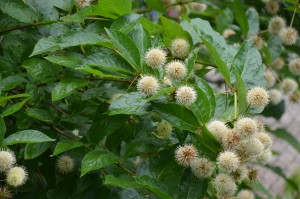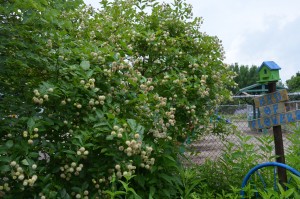Buttonbush (Cephalanthus occidentalis), aka Button-willow or Honey Bells, is a medium to large native shrub with many fine landscape attributes. This unique flowering shrub is a favorite in attracting beneficial wildlife. It populates bogs, swamps and pond areas, as well as dry limestone bluffs in the eastern U.S. and southeastern Canada (USDA hardiness zones 5–9).
White pompom flowers are the unique ornamental asset. Tiny fragrant flowers appear in creamy white balls that are 1 – 1 ¼ inches in diameter in late spring (in Philadelphia, PA) to early summer (northern New England). Long projecting styles from the flower heads gives it a distinctive pincushion appearance. Flower heads mature into hard spherical ball-like fruits containing tiny two-seeded nutlets. Dried seed balls persist all winter long.
Give the buttonbush room to grow. This multi-stemmed deciduous shrub grows 6-12 feet tall and 4-7 feet wide. On older shrubs stems and trunks appear twisted when twigs are bare of leaves in winter. Pruning is usually unnecessary and is done in early spring to shape or reduce plant dimensions. Old neglected plants may be revitalized by cutting them back near to the ground in late winter.
Buttonbush has year-round garden interest with late spring flowers, summer and fall foliage, and fall/winter fruits. Narrow oval green deciduous leaves emerge in spring and turn shades of red in fall. It has no serious disease or insect problems. Foliage is poisonous to humans and livestock; deer may snack on new spring growth.
Buttonbush is best planted in wet, humus-rich soils and in full sun to part shade. Favorite landscape sites include in rain gardens or the edge of ponds. Established plants after 1-2 years are moderately drought tolerant.
Fragrant flowers attract butterflies, bees, and hummingbirds for nectar. Leaves are the larval host for some butterfly species. Waterfowl, quail, and other birds feed on the nut-like seeds. Cut flowers look great in fresh summer bouquets or in dried arrangements.



 Posted in
Posted in 
